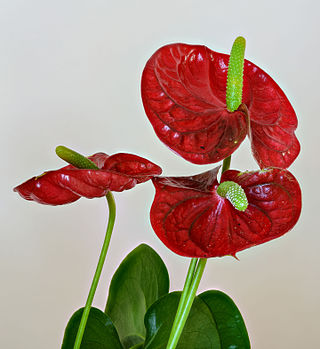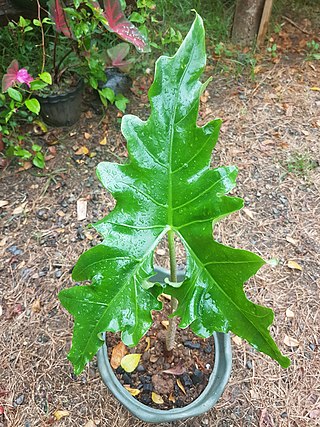
Anthurium is a genus of about 1,000 species of flowering plants, the largest genus of the arum family, Araceae. General common names include anthurium, tailflower, flamingo flower, pigtail plant, and laceleaf.

Nepenthes naga is a tropical pitcher plant endemic to the Barisan Mountains of Sumatra. It is characterised by a forked sub-apical appendage on the underside of the lid and an undulate lid margin. The specific epithet naga is the Indonesian word for "dragon" and refers to the distinctive lid appendage of this species as well as the large size of its pitchers. The name also references local folklore, which tells of dragons occurring in this species's habitat in the past.

Brunfelsia latifolia, commonly known as yesterday-today-tomorrow and kiss me quick, is a species of flowering plant in the nightshade family. Endemic to Brazil, it is an evergreen shrub that becomes semi-deciduous in cooler areas and grows up to 1.8 meters in height.

Fieldia australis, usually referred to as fieldia, is a small climbing plant or epiphyte found in the rainforests of eastern Australia, ranging from southeastern Queensland to Victoria. It is the sole species in genus Fieldia. Commonly seen in the cooler rainforests at higher elevations, it also grows in the warmer rainforests with a high humidity. The plant uses adventitious roots to grip hold of tree trunks, mossy rocks or tree ferns.

The micrantha is a wild citrus from the papeda group, native to southern Philippines, particularly islands of Cebu and Bohol. Two varieties are recognized: small-flowered papeda, locally known as biasong, and small-fruited papeda or samuyao.

Anthurium clarinervium is a species of flowering plant in the family Araceae native to Chiapas, Mexico. The Anthurium genus is known to contain approximately 1,000 species, resulting in one of the most diverse Central American tropical plant genera.

Arisaema propinquum, or Wallach's cobra lily, is a species of flowering plant the family Araceae. Arisaema propinquum occurs in the Himalayas.

Anthurium schlechtendalii, also known as pheasant's tail or cola de faisán in Spanish, is a broad-leafed plant used for multiple medicinal purposes, including muscle and joint sprains, back pain, arthritis and rheumatism.

Vigna parkeri, the creeping vigna or vigna menjalar, is a climbing or prostrate perennial vine that grows in subtropical areas such as Kenya, Indonesia, and Madagascar.

Passiflora bogotensis is a climbing plant native to Colombia, in the genus Passiflora. It can also be found in Venezuela.

Prunus himalayana, called jyokun shin in Tibetan and 喜马拉雅臭樱 in Chinese, is a species of Prunus native to Nepal, Bhutan, Sikkim and Tibet. It prefers to grow 2,800 to 4,200 m above sea level in the Himalayas. As Maddenia himalaica it was the type species for the now unrecognized genus Maddenia.
Passiflora quetzal is a species of flowering plant native to Mexico and Guatemala described in 2004. It is named after the quetzal, which inhabits the area.
Zanthoxylum laetum is a species of woody plant from the Rutaceae family.

Alocasia nycteris, commonly known as the bat alocasia or the batwing alocasia, is a plant in the family Araceae. It is endemic to island of Panay in the Philippines. It is cultivated as an ornamental plant.

Epipremnum giganteum is a species of flowering plant in the genus Epipremnum.

Anthurium coloradense is a species of plant in the genus Anthurium native to Panama. A member of the section Polyneurium, this terrestrial shrub is most recognizable by its thin, veined leaves and its yellow-green spadix. Its foliage is very similar to other Panamanian species such as Anthurium caperatum, Anthurium santamariae and Anthurium cerrosantiagoense but may be distinguished by details such as the grooves in its stems and the pattern of veining, with the collective vein growing from the third vein in a leaf.

Lilium nanum is a species belonging to the lily family (Liliaceae). The species is widespread throughout the Himalayas and is one of the genus's smallest species. Lilium nanum was discovered in 1845 on a journey by Prince Waldemar of Prussia. The name was first described in 1860.

Anthurium wendlingeri is a species of aroid plant, in the genus Anthurium, found from Central to South America, from SE Nicaragua to NW Colombia. It grows in moist, montane tropical habitats as an epiphyte. Unique among its genus, A. wendlingeri has long, pendant and strap-like leaves, and can have a slightly velvety appearance.
Peperomia villipetiola is a species of plant from the genus Peperomia. It was first described by Casimir de Candolle and published in the book "Notulae Systematicae. Herbier du Museum de Paris 3: 43. 1914.". It is endemic to Peru. First specimens were collected by Vidal-Sénège, M. Its etymology came from the words "villi" and "petiola".

Crateva tapia, commonly known as toco, payaguá, naranjuelo, or beach apple, is a member of the genus Crateva, belonging to the family Capparaceae. It is native from Mexico through Central America into South America as far as south Brazil.
















